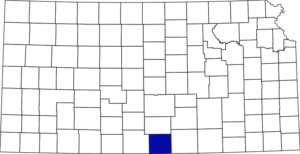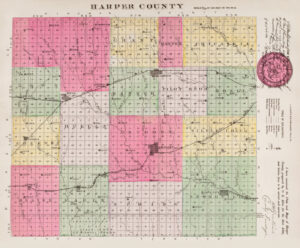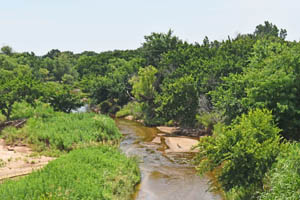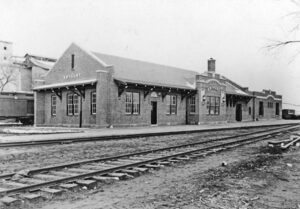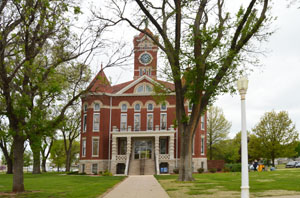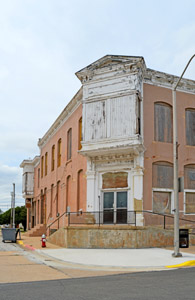Towns & Places:
Anthony – County Seat
Attica
Bluff City
Danville
Harper
Bluff Creek
Harper County, Kansas, is located in the southcentral part of the state. Its county seat and most populous city is Anthony. As of the 2020 census, its population was 5,485. The county has an area of 803 square miles, of which 801 square miles is land and 1.5 square miles is water.
Harper County was established in 1867 and named for Sergeant Marion Harper of the 2nd Kansas Cavalry, who died in battle during the Civil War. The lands were originally part of the “Osage Trust Lands” that the Osage Indians had received in an 1825 treaty. The county is bounded on the north by Kingman County, on the east by Sumner County, on the south by the State of Oklahoma, and on the west by Barber County.
The general surface of the county is rolling, with long, gentle slopes. The bottom lands initially comprised about 15% of the total area, averaging a mile in width. The timber was sparse, mostly cottonwood, and several artificial plantings existed. Red sandstone, mineral paint, and salt were found in large quantities and were of superior quality. The most significant stream is the Chikaskia River, which flows across the northeast corner. Bluff Creek and its numerous tributaries form most of the county’s water system. This stream crosses the county in a southeasterly direction.
The organization of Harper County in 1873 proved to be one of the most gigantic frauds ever perpetrated in connection with county organizations. In 1873, three men from Cherokee County named Boyd, Wiggins, and Homer, having laid a scheme to organize some of the uninhabited lands of southwestern Kansas for exploitation, came into what is now Harper County, where they met a trapper by the name of George Lutz, who took them to his camp. Taking Lutz into their scheme, a petition was drawn asking that John Davis be appointed special census taker and that H.H. Weaver, H.P. Fields, and Samuel Smith be appointed special county commissioners. These names were copied from a Cincinnati, Ohio directory, and the men used buffalo bones to mark out the houses.
The petition further asked that the then-fictitious town of Bluff City, which was “centrally located in the county, and being the largest and most important business point in the county,” be made the temporary county seat. Forty names were attached to this petition. The governor granted the petition, and a census report was sent, which showed 641 names of people declared to be “bona fide” residents. The county was then declared organized.
However, the following winter, an investigating committee appointed by the legislature visited Harper County and found that it did not have a single resident, had been bonded for $25,000, and had a funded indebtedness of $15,000. A.W. Williams, then attorney-general of Kansas, recommended that the organization be invalidated for fraud and that the county be attached to some other one for judicial purposes. Naturally, these events gave Harper an unsavory reputation for some time.
M. Devore and family made the earliest settlement in Harper County, H.E. Jesseph and family, John Lamar and family, and William Thomas and family, all of whom settled near the county’s east line in 1876. The following year, a colony from Iowa was settled on the site of Harper City. They came to Hutchinson on the railroad and drove from that point.
The county was organized in 1878. In August, Governor Tobey Anthony appointed the following officers: Sheriff E. McEnany; Surveyor B. F. Lee; Treasurer J.L. Rinehart; Clerk H.E. Jesseph; Probate Judge R.B. Dawson; Attorney W.R. Kirkpatrick; Register of Deeds, H.C. Fisler; County Superintendent of Public Instruction, R.H. Lockwood; county commissioners, T.H. Stevens, F.B. Singer, and J. B. Glenn.
A town company located the site for Anthony on April 6, 1878. The first buildings put up by the Town Company included barracks for emigrants. Soon, there was a general merchandise store, a drug store, and a hardware store. The post office was established on June 14, 1878, and the town was incorporated in 1879.
Anthony was named the county seat at the commissioners’ first meeting, and 20 townships were created. The first county seat election was held during the general election in November 1879. Although the county did not have more than 800 legal voters then, 2,960 votes were cast. The county commissioners refused to count the ballots and left them in the boxes. When they finally decided to count them, they had all disappeared. The citizens of Anthony and Harper, the two contesting towns, engaged in a legal battle over the matter. Although Justice Brewer of the Supreme Court held that 2,960 votes were too many for 800 voters to cast, the vote was finally counted and found to favor Anthony. That town became the permanent county seat, and all the officers of 1878 held over until 1880.
On July 10, 1880, bonds of $28,000 were voted for the Southern Kansas & Western Railroad, with Harper Township voting $16,000 and Chikaskia $12,000. The road was built that year and was soon running to Harper.
On January 10, 1881, the city of Anthony held an election to issue 12 bonds of $250 each, to run ten years and bear 10% interest, the proceeds to be used to construct a town hall and jail. The bonds were carried and sold to S.L. Davidson for $2,880. Work immediately began on the Courthouse, and on May 31 of the same year, the city of Anthony donated the city hall to the county in consideration of $1. This donation was accompanied by the stipulation that when the county ceased to use the hall for courthouse purposes, it should revert to the city. The $3,000 voted by the city made a neat and habitable building.
Within a few years, the county had a network of railroads. A line of the Atchison, Topeka & Santa Fe Railroad entered the north-central part and crossed south through Harper and Anthony into Oklahoma. Another line of the same road entered the east, somewhat north of the center, passed through Harper, and crossed Barber County into Oklahoma, and a branch diverged northwest from Attica. The Kansas City, Mexico & Orient entered the northeast, crossed southwest to Harper, then to Anthony, and southwest into Oklahoma. The Chicago, Rock Island & Pacific Railroad entered from Oklahoma in the southwest and terminated at Anthony. Anthony was also the Kansas Southwestern Railway’s western terminus, which entered the southeast. The Missouri Pacific Railroad, from the east, crossed southwest to Anthony and terminated at Kiowa in Barber County just over the line. There were 167 miles of main track in the county.
The Mennonites settled in Harper and organized a Mennonite church. Runnymede was a British settlement founded to attract young, wealthy British men to farm the area. French Catholics settled in Danville. The Amish Mennonites settled in Crystal Springs in the early 1900s.
A new Harper County Courthouse was constructed in 1908 and dubbed “Pride of Harper County.” Architect George P. Washburn designed the red brick and limestone building. The three-story building had an attic and a full basement. Cornerstone ceremonies were held on January 29, 1908, conducted by the Officers of the Kansas Masonic Grand Lodge. The total cost of the building, including electric wiring, fixtures, heating and plumbing, wood furniture, steel vault furniture, plans, and supervision, was $76,560.98. The Courthouse was dedicated on November 10, 1908. It was listed on the National Register of Historic Places in August 1978.
By 1910, 400,000 of the total 518,400 acres had been cultivated. The value of farm products averaged from $3,000,000 to $3,500,000 annually. The 1910 yield was not as large as in 1909, but the wheat sold for nearly $1,000,000, the corn for $356,000, and the oats for $349,000. The total product, including livestock, was worth $2,980,000. The assessed property valuation was $29,272,300, which showed the average wealth per capita to be almost $2,000.
That year, Harper County’s population peaked at 14,748, a gain of about 35% over the population in 1900. In the following decades, the county’s population gradually fell.
However, that briefly changed in 2010 and 2011, when the area seemed poised for a gold rush. Oil was found across vast swaths of southern and western Kansas. Large out-of-state oil exploration companies bought leases at ten times previous prices. By 2012, rental housing and office space in Danville, Harper, and Anthony had more than quadrupled in price.
However, by the following year, most oil companies had given up, cut their losses, and pulled out, victims of the complexity of drilling horizontal wells. The biggest blow came when Shell Oil confirmed that it was looking to sell its 45 wells and 600,000 acres of leases.
By 2016, the oil fracking boom had played out, and the economies of Harper and the adjacent counties suffered. With induced seismicity from injection wells, earthquakes were substantially reduced in frequency and intensity due to a Kansas Corporation Commission order mandating cutbacks in volumes and pressures. Two major producers in Harper County appealed the order but soon went bankrupt.
©Kathy Alexander/Legends of Kansas, updated November 2024.
Also See:
Blackmar, Frank W.; Kansas: A Cyclopedia of State History, Vol I; Standard Publishing Company, Chicago, IL 1912.
Cutler, William G; History of Kansas; A. T. Andreas, Chicago, IL, 1883.
Fort Hays State University
Travel Kansas
Wichita Eagle
Wikipedia


